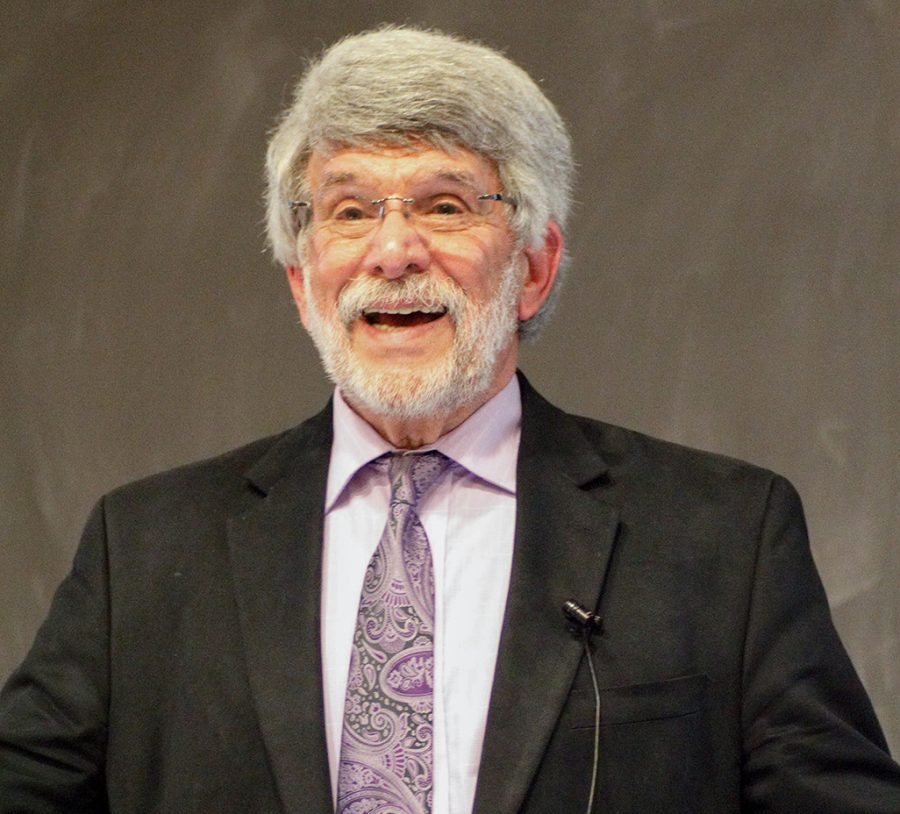Holocaust survivor comes to UNI
Former NASA engineer tells story of surviving as a child in the WWII German occupation of Hungary.
Peter Gorog is a Holocaust survivor who was brought to UNI as a part of a lecture series funded by Norman Cohn.
Apr 6, 2017
The UNI Center for Holocaust and Genocide Education hosted the ninth Annual Norman Cohn Holocaust Remembrance and Education Lecture at the Curris Business Building on Tuesday, April 4, at 7 p.m.
The presenter was a Holocaust survivor and retired NASA engineer Peter Gorog, who now works in conjunction with the Office of Survivor Affairs of the United States Holocaust Memorial Museum in Washington, DC.
Gorog also makes it his mission to remember the child victims of the Holocaust who were not as lucky as he was.
“Preserving the memory of the one million children who were killed in the Holocaust is extremely important for me personally,” Gorog said.
This is the ninth consecutive year of the lecture series funded by Norman Cohn, a Waterloo native and a graduate of Iowa State Teacher’s College (now UNI). Cohn established the lecture series to promote Holocaust awareness and education.
Stephen Gaies, director of the Center for Holocaust and Genocide Education, began the event by introducing the lecture series and then introducing Gorog, who spoke to a full crowd in Curris Room 109.
Gorog was born in Hungary in 1941 as Péter Grünwald. Born into a Jewish Orthodox family, Gorog described the anti-Semitism that ran rampant in Hungary at the time. His father, Arpád, was taken to a Hungarian forced labor camp in 1940.
According to Gorog, his father would send postcards back to his family, but they were heavily censored and did not reveal much about his life in the camp. Gorog’s mother, Olga, kept diaries about their lives in Hungary and the details of young Peter, hoping to show Arpád all that had occurred in his absence upon his return.
“Unfortunately, that didn’t happen,” Gorog said at the lecture.
In 1943, Olga received an official notice from the Hungarian Minister of Defense that Arpád had disappeared. Most men in Hungarian labor camps died of exposure during the harsh Russian winter, without enough food, proper clothes or medical care to sustain them.
Gorog pointed out that Hungary was not occupied by Nazi Germany until the war was nearly over in 1944. Hungary has a long history of anti-Semitism, and the Hungarian government has since admitted to being complicit in the deaths of 600,000 out of 800,000 Hungarian Jews in World War II.
Gorog and his mother were forced to leave their apartment in 1944 and hide in the apartment of a Catholic friend. Days later, they were reported and had to move to an apartment building owned by the Swedish Embassy. Swedish diplomat Raoul Wallenberg bought apartment buildings in Hungary, making them protected by international law.
“He single-handedly saved tens of thousands of Jewish people,” Gorog said of Wallenberg.
Among the number safeguarded by Wallenberg were Gorog, his mother and his grandparents.
Gorog recalled playing in an inner courtyard with other Jewish children, pretending to shoot each other with sticks. A Hungarian Nazi, who was not permitted on the grounds, saw the children and entered. He gave the children a real weapon, sans ammunition, to play with. Soon after, he was discovered and removed.
“He found pleasure seeing these little Jewish boys wearing the Star of David shooting each other, even if it was just playing,” Gorog said.
Eventually, when the Nazis invaded Hungary, every Jew from the buildings owned by Wallenberg were rounded up to either be sent to concentration camps or shot at the bank of the Danube River.
According to Gorog, by “sheer luck or divine intervention,” the young Nazi who had given Gorog and his friends a weapon recognized Gorog and his mother and requested they be left behind.
After the Nazis left them, Gorog and Olga moved to the Budapest ghetto to wait out the rest of the war. Bombs ravaged Hungary, but Gorog and Olga survived, and in 1945, they were freed from the Jewish ghetto.
Unable to leave, Gorog lived under the Communist system in Hungary. He earned a Master of Science degree in electrical engineering in Hungary, which he used to get a job at NASA in the United States when he defected in 1980.
He worked at NASA for the next 34 years, contributing to projects such as the Hubble Space Telescope and the upcoming James Webb Space Telescopes. He retired in 2014 and now volunteers at the Holocaust Memorial Museum, giving lectures, leading tours and translating documents — including the diaries his mother kept in Hungary.
As far as his message to society, Gorog encourages people of all nations to “be aware of what’s going on around us.”
“We cannot be bystanders,” Gorog said. “We all have the responsibility to not only raise our voice — it’s also important what we do.”








